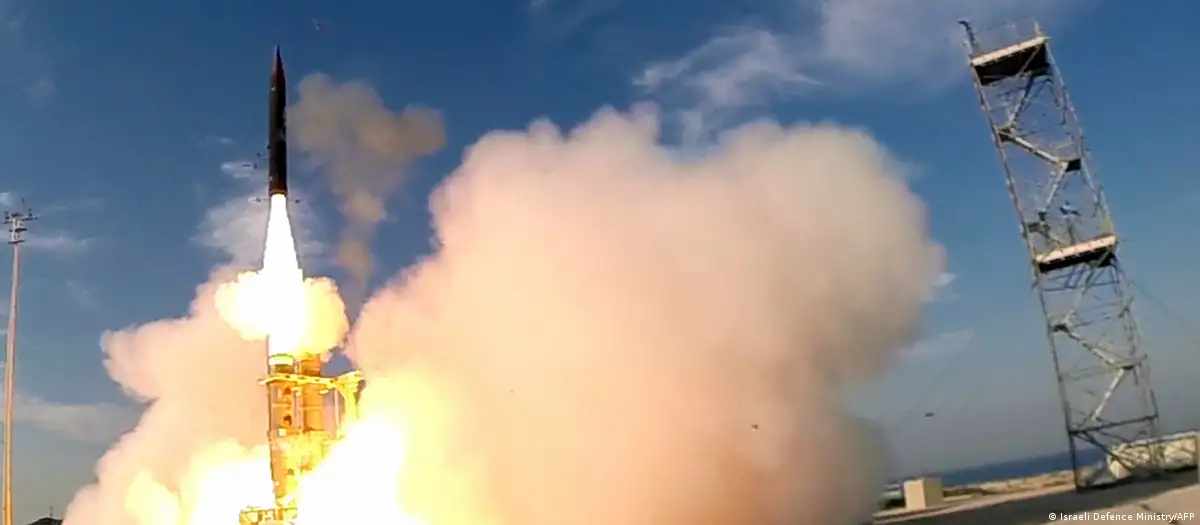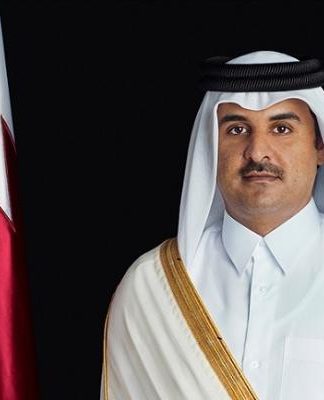POLITICSGERMANY
Sky Shield Initiative: Can it protect Europe?
Ralf Bosen
3 hours ago3 hours ago
The Sky Shield air defense system initiated by Germany intends to bolster NATO’s protective capacity over Europe. How effective would it be?
https://p.dw.com/p/4Whzr
Launch of an Arrow-3 interceptor rocket
Arrow-3 interceptor rockets are to be part of the planned ‘Sky Shield’Image: Israeli Defence Ministry/AFP
The invasion of Ukraine by Russian troops has brought war back to Europe — and thrown the defensive capabilities of NATO and Europe into the spotlight. Now, rearmament efforts are underway and new defense strategies are being prepared. This includes protection against possible Russian missile attacks in case the war over Ukraine escalates and other European countries could come into confrontation with Moscow.
However, NATO’s protective shield for Europe has some holes. The air defense system, which Germany launched last October, is intended to close them. At that time, on the sidelines of a NATO meeting in Brussels, 15 countries signed a memorandum of understanding to set up a European air defense system. Along with Germany, the signatories were: Belgium, Bulgaria, Estonia, Finland, the UK, Latvia, Lithuania, the Netherlands, Norway, Romania, Slovakia, Slovenia, the Czech Republic and Hungary. Later, Denmark, Sweeden, Austria and Switzerland also joined the initiative.
What is the European Sky Shield Initiative?
01:37
German Chancellor Olaf Scholz, of the Social Democrat party (SPD), spoke of an “increase in safety for all of Europe,” and argued that a European air defense system would cost less and be more effective than if every individual country set up their own expensive and complex systems. However, France, Italy and Poland are yet to join the initiative. Paris criticized that technology from the US and Israel would be purchased for the project.
The goal of the European Sky Shield Initiative (ESSI) is to achieve the most well-coordinated defense system against short, medium and long-range threats from the air. On its website, the German Defense Ministry defined short-range as up to 15 kilometers (9 miles) in distance across land and 6 kilometers in altitude. The medium range is 15-50 kilometers wide and up to 25 kilometers high. Long-range is more than 50 kilometers wide and up to 35 kilometers in altitude.
IRIS-T to protect against drone attacks
“In all three areas, there are gaps in capability which the ESSI would close, or already means available which could be further developed or strengthened,” the German Defense Ministry wrote.
Germany’s Chancellor Olaf Scholz speaking to the press at an European Union leaders’ summit in Brussels, Belgium October 20, 2022.Germany’s Chancellor Olaf Scholz speaking to the press at an European Union leaders’ summit in Brussels, Belgium October 20, 2022.
German Chancellor Olaf Scholz says there will be an increase in safety for all of Europe, when the European air defense system is operationalImage: PIROSCHKA VAN DE WOUW/REUTERS
To achieve this, existing protective systems should be replaced by modern ones. An example of a replacement system is the IRIS-T, which can destroy incoming rockets, cruise missiles, drones, aircraft and helicopters at a distance of up to 40 kilometers and an altitude of up to 20 kilometers. The price per unit is about €145 million ($155 million). In June of this year, the German parliament approved the purchase of 6 IRIS-T fire units in its budget. The German Air Force is already familiar with this system because it has trained Ukrainian soldiers to use it. Germany has so far supplied two of these units to Ukraine.
For long-range air defense, the Bundeswehr uses the Patriot (Phased Array Tracking Radar to Intercept on Target) weapons system, which is still considered effective but can be modernized. The US-sourced ground-based anti-aircraft missile system can be used against planes, cruise missiles and intermediate-range ballistic missiles. Since 1984, the Patriot has been used by a multitude of armed forces, including the Bundeswehr. Germany currently has 12 Patriot launches, far from enough to cover the whole country.
Israel clinches largest-ever defense deal with Germany
02:43
Defenses against cruise missiles also need to be readjusted. Because they fly at such low altitudes and are therefore detected very late, defending against them is usually only possible with modern systems such as Patriot or IRIS-T. That is why, according to the Bundeswehr, comprehensive protection of the area is “enormously expensive and only possible with many systems, which illustrates the need for a multinational approach.”
Another gap in defenses is when it comes to long-range ballistic missiles, which can also head for their targets from beyond the earth’s atmosphere. “These gaps must be closed quickly, especially since Russia already has these weapons. Germany must be able to protect itself against the threat of missiles with ranges of more than 1000 kilometers more quickly than it had planned,” the German Defense Ministry wrote.
Arrow 3
Defense Minister Boris Pistorius and his Israeli counterpart Joav Galant signed an agreement for the purchase in Berlin on Sept. 28. According to the Defense Ministry in Tel Aviv, this is the country’s largest arms deal to date. It amounts to a volume of more than 3.2 billion euros. The purchase is also seen as a symbol of the close cooperation between Israel and Germany.
Arrow 3 was jointly developed by Israel and the United States. It was first deployed at an Israeli airbase in 2017. Unlike the Iron Dome missile shield, which protects Israel primarily from attacks from Gaza and Lebanon, the Arrow system is designed to defend against long-range missiles
Arrow 3 can destroy attacking missiles up to a height of about 100 kilometers in incipient space and has a range of up to 2400 kilometers. Because of its much longer range than the Patriot air defense system and the IRIS-T system previously deployed in Germany, Arrow 3 is considered an important addition to Germany’s existing missile defenses.
This is intended to be achieved by the US-Israeli missile defense system Arrow 3, which Germany is due to have up and running by the end of 2025. The Bundestag’s budget and defense committee approved the purchase in June. The costs amount to about €4 billion, according to Israeli sources. Arrow 3 can destroy attacking weapons systems at an altitude of more than 100 kilometers, which is at the edge of space, just beyond the earth’s atmosphere, and has a range of up to 2,400 kilometers. Like the “Patriot” system, “Arrow 3” is operated with a mobile launching device, a mobile control station, a mobile radar station and guided missiles.
How can EU boost air defenses?
03:00
The countries involved in the European Sky Shield Initiative want to work together to procure the weapons systems required to cover a large area in the most cost-effective way. Attention should be paid to the needs of each country.
The ESSI members want to support each other with the defense systems and the corresponding ammunition. The intention is that by working together to procure and maintain these systems, they will save on purchase and operating costs.
This article was originally written in German.
This article was updated to include the signing of the Arrow 3 agreement by Germany and Israel on September 28, 2023.
While you’re here: Every Tuesday, DW editors round up what is happening in German politics and society. You can sign up here for the weekly email newsletter Berlin Briefing.






























